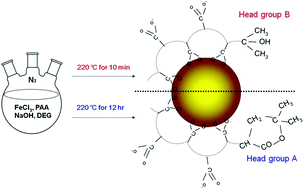Protein binding for detection of small changes on a nanoparticle surface†
Abstract
Protein adsorption on nanoparticles is closely associated with the physicochemical properties of particles, in particular, their surface properties. We synthesized two batches of polyacrylic acid-coated nanoparticles under almost identical conditions except for the heating duration and found differences in the head-group structure of the polyacrylic acid. The structure change was confirmed by NMR and MS. The two batches of particles had varied binding affinities to a selected group of proteins. Computational work confirmed that the head group of the polymer on the surface of a nanoparticle could directly interact with a protein, and small structural changes in the head group were sufficient to result in a significant difference in the free energy of binding. Our results demonstrate that protein adsorption is so sensitive to the surface properties of particles that it can reveal even small variations in the structure of a nanoparticle surface ligand, and should be useful for quick assessment of nanoparticle properties.


 Please wait while we load your content...
Please wait while we load your content...